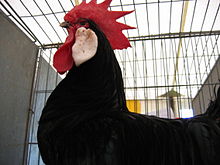Minorca (chicken)
 |
|
| Other names | |
|---|---|
| Country of origin | Spain |
| Distribution | worldwide |
| Traits | |
| Weight |
|
| Egg color | white |
| Comb type | single; rose |
| Classification | |
| APA | Mediterranean |
| ABA | single comb, clean legged rose comb, clean legged |
| EE | yes |
| PCGB | soft feather: light |
|
|
The Minorca, Catalan: Gallina de Menorca, Spanish: Menorquina, is a breed of domestic chicken originating in the Mediterranean island of Menorca, in the Balearic Islands to the south-east of Spain. It is a well-known exhibition bird in many countries of the world, but in the island of Menorca is an endangered breed and considered to be at risk of extinction.
The international type of Minorca was created by the British from indigenous Menorcan birds. This process began during the British occupation of the island from 1708 to 1783, but It is not clear if it took place there or in Britain. It is likely that it began in Menorca and continued in Britain, where imports of chickens from Menorca in the 1780s are documented. By about 100 years later, the breed (which was considered a variety of the "Spanish") was common and long-established in Devon and Cornwall, in the south-west of England, where it was highly regarded as an egg-laying breed. It had been exhibited in Paris, under the name "Barbezieux", and was widespread in the world. It reached Germany in the late 1870s, and was added to the Standard of Perfection of the American Poultry Association in 1888.
Various attempts were made to modify some of the physical characteristics of the breed, including body size (by cross-breeding with the Langshan), the size of the comb and earlobes, and the position of the neck. None of these attempts had any beneficial effect on its abilities as an egg-layer.
Until recently the Minorca was uncommon in its island of origin. In 2004 a project to assess the numbers and quality of the remaining stock in the farms and country houses of the island was completed at the Centre de Capacitació i Experiències Agràries de Mao, the agricultural college of Mahón, and the results published in 2006. A breeding flock selected for quality and consisting of 30 cocks and 150 hens was established at the college, and 600 birds distributed to local breeders.
...
Wikipedia
